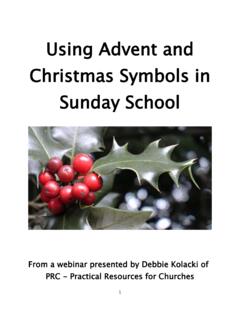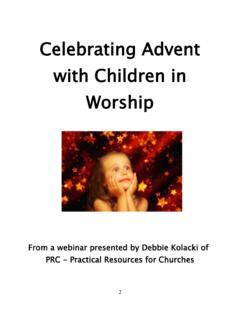Transcription of Making Lent More Meaningful to Children - prcli.org
1 1 Making lent more Meaningful to Children By Debbie Kolacki of PRC - Practical Resources for Churches 2 From Christmas to lent It seems that the Christmas decorations and Advent wreaths have just been stored away when we find that it s time to start preparing for lent . Looking at things from the perspective of Children who may not know the whole story of Jesus, they re probably still thinking about that cute little baby in the manger and next thing they know the baby has grown into an adult and is being killed. So how can we best help Children make the transition from the joyful celebration of Christmas to the rather somber observance of lent and Holy Week? The season of lent offers those in Children s ministry an opportunity to give Children a balanced view of life, to let Children know that there are times in life when they will be sad, while reassuring them that, no matter what happens, God is always with them to help them get through tough times.
2 This approach can lead to a lasting faith as opposed to a shallow faith which is based on the idea that those who have faith in God are magically protected from anything bad. Depending on the age of the Children you minister to, there are scripture passages which you can discuss with them to help them understand this duality of life. Ecclesiastes 3 comes to mind: To everything there is a season, and a time for every matter under heaven: a time to be born, and a time to die; a time to plant, and a time to pluck up what is planted; ..a time to weep, and a time to laugh; a time to mourn, and a time to dance. (NRSV) I also think of the passage in John 16 when Jesus says In the world you face persecution. But take courage; I have conquered the world! (NRSV) 3 Children and lent We adults sometimes think that Children can t understand spiritual concepts, but Children have an innate spirituality and curiosity about God and spiritual things. To help Children to understand what lent is, you can tell them that it is a special time in the church year when we focus on spiritual things and do things that bring us closer to God.
3 Years ago, when Children were introduced to the season of lent , there was a big emphasis on giving something up, usually a favorite food or perhaps a pleasurable activity. There s nothing wrong with suggesting that Children give something up for lent , as long as they understand why they re doing it and do it in the right spirit. So it s important to explain that giving something up for lent can help us focus on God and that depriving ourselves of something we like gives us an appreciation for all we have. It s also a good idea to have the Children do something positive related to what they re giving up. For instance, if they ve given up candy for lent , then they could take the money they would have spent on the candy and put it in a jar to be used for an organization which helps Children in need. If they ve decided to give up watching television one day a week, then they could use the time they would have spent watching TV helping someone or praying.
4 Instead of focusing on giving something up, we can help Children learn about giving to others by having a church wide or Sunday school service or mission project for the season of lent . Research shows that the most important factor in a child s faith formation is the family, so it s important to partner with families and provide them with resources so that they can celebrate lent in the home. There are family devotionals and activity booklets available from places like Creative Communications for the Parish and Christian Tools of Affirmation. You can send suggestions for family Lenten activities by email or post them on your church website or Facebook page. There are also plenty of free online resources for families. You should also involve the Children with the rest of the congregation through intergenerational worship and programs. It s important for Children to not only learn about lent but to see how adults celebrate lent . 4 Activities for lent There are a number of activities to do with Children to help them learn about lent .
5 Pinterest is a good place to find all sorts of different ones. You can teach Children about Ash Wednesday, when lent begins, by explaining that in the past people used to put ashes on themselves as a sign that they wanted to repent and be a better person. lent is a season when we make an effort to live the way God wants us to by praying and acting loving to other people. A Lenten calendar, similar to an Advent calendar, can have different activities for each day of lent . The same concept can be used to create a Lenten journey path. You can show a path on paper leading up to the empty cross and have stepping stones which the Children can color in each day to see how close they are getting to Easter. Since lent is a prayerful time, Making prayer books is another good Lenten activity. You can also create other items related to praying such as prayer beads. Almsgiving is an important part of lent ; you can have the Children create Lenten banks for a special mission project.
6 Children can also create a Jesus Tree for lent that is similar to the Jesse Tree for Advent. A bare tree can be made of twigs, felt, or paper and an ornament is added for each day in lent ; the ornament symbolizes a Bible story that the family reads together. Lenten love chains can be used to decorate a classroom or another area. Children write a loving action that they will do during lent on a slip of paper and then the papers are glued or stapled together to create a chain. A Lenten grapevine can be made in Sunday school and then sent home for the family to use during lent . A bare grapevine is made of brown paper; there are also leaves and grapes which the Children can add to the grapevine for every good deed they do during lent . 5 Symbols of lent There are lot of Lenten symbols you can use when teaching Children about lent and Holy Week. If you do a classroom activity based on a symbol and send the Children home with a tangible object it will serve as a reminder of the symbol and its meaning.
7 The pretzel is a symbol of lent with a fun legend about it. A monk made special bread without eggs or milk (because they didn t use these in lent ) and shaped it so that it would look like the arms of someone praying. In those days people often prayed with their hands crossed over their chest. You can find many activities online related to the legend of the pretzel. Water can also be a Lenten symbol. It has many meanings and one is as a reminder of our baptism. Making a bowl or other container for water and then encouraging the Children to place it somewhere in their home to remember their baptism could be a Meaningful activity. You could also suggest that Children ask their parents about their own baptisms and whether there are any photos of them on the day they were baptized. Palm leaves are a Lenten symbol and you can find directions online to make the traditional Palm Sunday ones into crosses. The cocoon with the caterpillar inside which transforms into a butterfly is just one of many symbols for lent which symbolize new life.
8 There are plenty of craft and other activities related to this symbol. Children love animals and the donkey is a symbol for lent . There are stories and books written from the perspective of the donkey that Jesus rode on as he entered Jerusalem on Palm Sunday. The rooster is a symbol of lent and reminds us that Peter denied Jesus three times before the rooster crowed. The story of Peter s denial and how Jesus forgave him is a good story to share with Children to teach them about friendship and forgiveness. An article from the Ministry Matters website called lent for Kids: Focusing on God s Time includes classroom activities for each week of lent focusing on symbols. 6 Teaching about Holy Week Some Sunday school curriculums will cover one part of Holy Week each Sunday over the course of the 4-5 Sundays before Easter. It s a good idea to include an overview of Holy Week which includes Easter for each of those lessons for two reasons. One is that, in most Sunday schools, attendance is sporadic, so if a child only attends on one of the Sundays before Easter they won t get the whole story.
9 Also, it s important to always remind Children that, although Jesus died, that s not the end of the story. There are some wonderful things you can teach your Children about the events of Holy Week. On Palm Sunday, as we talk about the triumphal entry of Jesus into Jerusalem, we can let the Children know that Jesus rode on a humble donkey because his power wasn t due to his physical strength but the power of love. The events during the Last Supper also offer many good opportunities for teaching. You might want to hold a Seder meal with the Children and teach them about the connections between the Jewish people and Christians. Foot washing (or hand washing) can show how Jesus was an example of humility, a trait which is mostly neglected or looked down upon in today s society. The Lord s Supper also provides a chance to teach Children about Holy Communion and how Jesus asked us to remember him by celebrating it together with others. For both Children and adults, learning about Good Friday gives them a deeper experience of Easter Sunday.
10 On the next page we look at some guidelines for teaching Children about the events of Good Friday. Easter is sometimes referred to as Resurrection Sunday and teaching about the true meaning of Easter gives us a chance to show Children that there s more to the holiday than Easter eggs and the Easter bunny. You might want to plan an activity during lent that culminates on Easter to show Children how the solemn time of lent leads up to the joyous celebration of Christ s rising from the dead. Some churches bury or put away the alleluias during lent and then bring them out again on Easter. Perhaps you could decorate the sanctuary or the trees outside with paper cocoons and surprise the Children by replacing them with butterflies on Easter morning. This provides a physical reinforcement of the message of Easter: although there is sorrow and death in life, Jesus has conquered death and there will be joy in the life to come. 7 What about the crucifixion?







